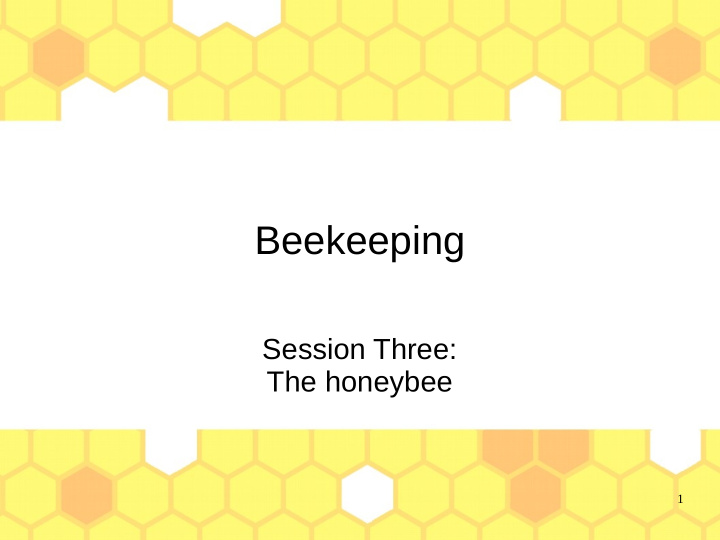



Beekeeping Session Three: The honeybee 1
Tonight’s Agenda ● Anatomy of the honeybee ● Life cycle ● Principal activities ● Supercedure ● Swarming ● Stings 2
Anatomy of the Honeybee ● Of the individual honeybee – Physical features – Life cycle ● Of the colony, as a social unit – The castes – Division of labor 3
Colony – Composition ● Castes – Workers, female, many thousands – Drones, male, a few hundred – Queen(s), female, usually one ● Population, bell curve – Object 1: prepare to forage – Object 2: prepare for winter ● Absence of leadership ● Dynamics – Environmental influences – Adjust and adapt 4
Members of the “Cast” Life Span: Six Weeks Three months Three to five years 5
Contributions – Functions ● Queen – Egg laying – Pheromone production ● Workers – Multiple functions – Progression through life, physical abilities – Quite flexible, depending upon colony needs ● Drones – Mating with virgin queens from other colonies – Take up space 6
Metamorphasis ● Egg => Larvae => Pupa ● Differential length of development ● Fertilization ● Effect of feeding 7
The Life & Times of a Worker Bee Part One: ● This process is similar metamorphasis to that of other – Egg (3 days) insects like 3 weeks – Larva (10 days) butterflies – Pupa (8 days) Begins immediately after Part Two: house duties ● emergence; as the – Cleanup worker bee ages she – Feed Brood moves from one duty – Care for the Queen About to the next; work is – Build Honeycomb 3 weeks based on needs of – Store Nectar & Pollen the colony; work is – Make Nectar into Honey done without – Guard Hive Entrance supervision Part Three: field duties ● Begins with orientation – Forage About flights; very efficient – Communicate use of effort; “tell” 3 weeks other bees where to find forage; work themselves to death 8
Worker – Physical Features 9
Principal Activities ● Seasonal urges – Spring build up – Swarming – Preparation for winter ● Foraging ● Climate control ● Sanitation ● Defense ● Construction of honeycomb 10
Yearly Cycle for the Colony 1--Healthy, 2--Swarmed, 3--Diseased 11
Foraging ● Objects sought – Nectar (carbohydrate source) – Pollen (protein source) – Plant resins – Water ● Abilities of note: Communication, navigation, heightened sensory capabilities ● Fidelity 12
Environmental Control ● Cooling ● Ventilation – Processing nectar into honey – Bearding ● Heating – Incubation – Cluster ● Sanitation (propolis) 13
Defense ● Protective behavior – Brood – Stores – honeycomb – Not exhibited while in swarm state ● Variable depending upon several factors ● True, even for Africanized bees ● Many forms of provocation * * poor weather conditions, fumes, vibration, predation, etc. 14
Production of Honey ● Discovery of nectar source ● Conveyance to hive, enzyme, honey stomach ● Transfer to house bees for placement ● Communicative dance—spread the word, recruit larger field force to tap source ● Concentrate plant sugars, reduce water content ● Airtight seal to protect honey from dilution ● Example of the abundance of nature 15
Honeycomb ● Built with wax biologically produced by bees ● Multi purpose vessel ● “Bee space” ● Typically parallel curtains, burr comb ● Suspended from horizontal surface ● Cells of two sizes ● Queen cells ● Architectural characteristics 16
Notes on Honeycomb ● Extremely high overhead cost for bees ● Consume 8# nectar to produce 1# wax ● Save/conserve wax when possible ● Brood comb is target of wax moths ● Brood cells diminish is size over time ● Contaminants accumulate, replace on cycle 17
Superscedure ● Object: replacement of an injured or unproductive queen ● Placement of queen cells – On face of frame – indicates superscedure – On lower edge of frame – signals intent to swarm ● Consequences ● Decision to allow/thwart superscedure 18
Notes on Queen Replacement ● Special feeding begins at hatching of egg ● Intercaste queen results if started late ● Seven to ten days after emergence, queen goes on mating flight ● Mates with 18-25 drones whle in flight, genetic diversity is an object ● Seven days after flight, begins to lay eggs ● Will not leave nest again, except to swarm 19
Swarming ● Reproductive strategy ● Typically in the spring ● Survival through following winter is a challenge ● Inhibits honey production of parent hive ● Diminishes parent colony population by half ● Signals of the swarm urge ● “Control” measures 20
Stings ● Mechanical aspects – Pheromone release – Separation of stinger and venom sac from bee ● Usually fatal to the bee ● Pheromone acts as signal of alarm, apply smoke to site of sting ● More likely to occur near colony nest ● Use care in removal of stinger ● Many stings caused by bee getting squeezed in clothing ● Calm, slow, fluid movement will help to minimize stinging 21
Q & A ● Anatomy and castes ● Life cycle ● Bee activities and behavior ● Superscedure ● Swarming ● Stings 22
Closing ● Next session ● Thank you 23
Recommend
More recommend